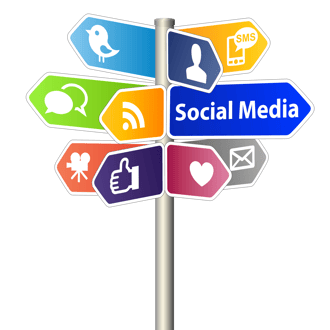Two guys walk into a bar…and talk all about themselves. Not the way the joke goes, we know, but bear with us. How many people would want to spark up a conversation with either of these bores when all they want to do is talk about themselves? Not many, and definitely not the two of us. So why is it that so many marketers and salespeople look at social media in a different way than a face-to-face conversation, or presenting at a conference?

It was dubbed “social media” for good reason. These channels are ideal for digital interaction, sharing, collaborating, and so much more. And it’s fine to use them for content marketing, but they are not effective when used as a sales channel. In fact, you will only alienate the community if you post commercial messages.
It’s easy to find good examples of the best way to communicate. Search your Twitter, Facebook, and LinkedIn, and see how those who have a big following are posting. Check out how the active social media educators are posting. Some of our favorite educators to follow on Twitter include Steven Anderson @web20classroom, Vickie Davis @CoolCatTeacher, Richard Byrne @rmbyrne, Michelle Luhtala @mluhtala, and Shannon Miller @shannonmmiller.
Browsing through their feeds, did you find any tweets where these thought leaders were talking about themselves? Maybe a few, but that’s okay because they are often truly “social” and are nicely mixed in with so much helpful information that is relevant to their audience. Their massive followings interact with this type of content all the time; when accounts like theirs post about themselves, their followers know and trust that they will get something useful out of the interaction as well.
Now, pick a few company Twitter handles at random. Try a few more established brands as well as a few younger companies. What do their Twitter feeds look like? Don’t get us wrong, there are some fantastic company social channels. However, more often than not we see commercial messages when looking at vendor feeds. What do their followings look like? Is there high engagement on their posts? If so, who is interacting? Customers? Other industry thought leaders? Those strange bot accounts that the company hasn’t gotten to blocking yet? Or maybe no one is. Maybe that content is falling on deaf ears and the time invested in generating and then promoting that content is wasted.
The Face-to-Face Test
We suggest treating social media, regardless of the channel, as if you were looking to engage in a face-to-face conversation and be recognized as a thought leader and expert in your field. What are some of the ways you start that conversation? Would you walk up to someone and simply begin talking about yourself? If you knew that person wasn’t interested in talking about cars right now, would you continue to shout about how great your cars are and how they can buy them? No, and no. But what if that person needs a car, just not this minute, or maybe they need the next model of car you will be offering. You wouldn’t want to scare them off for good by continuing to talk about your cars until they were ready to buy, would you?
Not a chance! You would look to find common ground, ways that you can interact with that person that are meaningful. What are their interests? Challenges? Goals? What if you could learn that information and provide a solution, maybe in the form of educational content or inspiration that led to earning their trust? The result would be an actual relationship, a partnership.
Listen Before You Speak
Social media is a powerful channel for forming deeper and broader relationships with teachers, administrators, librarians — any educator, at any level. This occurs when you treat it like the ongoing conversation that it is, not just a venue for free ad space. Odds are that if you prove yourself to be a competent and helpful presence online, your prospects will be far more receptive to information pertaining specifically to your products and services when they come up.
Just like you want to conceive of social media like a conversation rather than a pitch meeting, you want to be sure that your entering the conversation with the right social cues and appropriate “attire,” so to speak. Think about it: you wouldn’t show up to a neighborhood potluck outfitted for a black-tie gala. The tone and cadence of a social media conversation will vary from other marketing outlets that you’re using, and different social media chats may even have their own conversational norms.
Listening is one of your best tools in conversation and on social media. For anyone who has spent more time by the food than the people at a social function, you understand that picking up on the language and behavior patterns of others can be difficult at first. Give it time, listen to others whose online presence you respect, and don’t be afraid to commit to some trial and error. PR with Panache! (PRP) recently wrote a blog post about various social media tips and tricks that can help you get started looking like a pro on these channels.
Social Guidance
If you’re anything like us, then this talk about vibe and tone, and having a congenial conversation is all well and good — but where are the logistics?! As a true-to-heart marketing champ you want to know about process, baby! Pragmatism! Anything more concrete than “be a good listener”!
We get it, and we hear you. It is possible to harness those hardcore logistical skills to help build the sort of relatable but smart social media account that we are discussing. At PRP, we’ve also crafted a social media checklist that accomplishes just that.
While it’ll take your personality and perceptive nature to understand how your social media presence should look and feel, this checklist will help manage that activity. A huge part of becoming a trusted source online is keeping your content consistent, high-quality, timely, and on-message for your audience. The checklist breaks down each of these components, and tells you exactly what you need to do and when for your social account to truly take off.
Social media can seem like a big, isolating space at first. That said, we know from personal experience that once you get over some initial hurdles, the rewarding connections that you make from these platforms are genuinely worth the bit of extra effort. Happy posting!


